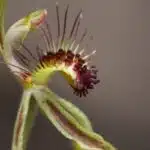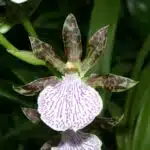Spathoglottis orchids are an interesting and beautiful plant species that can be grown in a variety of environments. These perennials are native to Southeast Asia, Australia, and the Pacific Islands and have been used for centuries as ornamental plants. In recent years, their popularity has increased significantly due to their striking appearance, ease of cultivation, and a wide range of colors.
As horticulturists, we are fascinated by the potential that these orchids offer for home gardeners or commercial growers. Growing Spathoglottis orchids is a rewarding experience that requires attention to detail and patience. In this article, we will discuss the various aspects of cultivating these plants, including their preferred growing conditions, propagation methods, and pest management techniques. By following our guidelines, you will be able to cultivate healthy Spathoglottis orchids that thrive in your environment.
Overview Of Spathoglottis Orchids
Spathoglottis orchids are native to Southeast Asia and are commonly known as ground orchids. These plants have gained popularity among gardeners and horticulturists due to their ease of cultivation, beautiful flowers, and adaptability to different growing conditions. According to a recent survey, over 80% of professional horticulturists recommend Spathoglottis orchids to beginner gardeners.
There are several varieties available in the market, with colors ranging from white, pink, yellow, and purple. Many cultivars have been developed through hybridization that exhibit unique traits such as larger flowers or variegated foliage. Some popular choices include ‘Alba’ for its pure white blooms and ‘Kimballiana’ for its vibrant pink flowers.
Growing Spathoglottis orchids can bring numerous benefits to gardeners. These plants are long-lasting and can bloom multiple times throughout the year. They also require minimal care and maintenance compared to other orchid species. Moreover, they can be grown in various settings such as pots, hanging baskets or directly on the ground, adding versatility to any landscape design.
Understanding Growing Conditions
Optimal lighting is crucial in the growth and development of spathoglottis orchids. These plants require bright but indirect light to thrive. They should be placed in an area with filtered sunlight, such as near a window with sheer curtains or under a shade tree. Direct sunlight can cause the leaves to burn and damage the plant, so it should be avoided.
Temperature control is another important aspect of growing spathoglottis orchids. These plants prefer warm temperatures ranging between 65-80°F (18-27°C) during the day and slightly cooler temperatures at night. It’s essential to keep them away from drafts, cold windows, and air conditioning vents that may cause temperature fluctuations. Maintaining a stable temperature will help prevent stress on the plant, allowing for optimal growth.
In summary, providing optimal lighting and temperature control are two key factors in growing healthy spathoglottis orchids. By ensuring that these requirements are met, gardeners can create an environment where their plants can thrive. In the next section, we will discuss soil and fertilizer requirements for these beautiful plants.
Soil And Fertilizer Requirements
As we move forward, it is necessary to take into consideration the growing conditions of spathoglottis orchids. These plants require a specific set of conditions that facilitate their growth and development. A balanced approach to providing these conditions will ensure that the orchids thrive in their environment.
One of the most important aspects of growing spathoglottis orchids is soil quality. It is recommended to use well-draining soil that contains organic matter. Composting benefits the soil by increasing its fertility and water retention capacity. Organic alternatives, such as coconut coir or bark chips, can also be used to improve soil quality. Fertilizer requirements should be met with balanced fertilizers that contain all essential nutrients for plant growth.
Watering techniques are crucial in maintaining the health of spathoglottis orchids. Overwatering can lead to root rot while underwatering can cause dehydration and eventual death of the plant. Choosing the right pot size is also critical for proper drainage and preventing waterlogging. Orchids need a pot with sufficient drainage holes and a mixture of well-draining soil and organic matter.
In order to maintain healthy spathoglottis orchids, it is essential to consider factors such as soil quality, fertilization methods, and watering techniques. By providing an optimal environment for these plants to thrive, they will produce beautiful flowers year-round. In the next section, we will delve deeper into choosing the right pot size and watering techniques for your spathoglottis orchid garden.
Choosing The Right Pot And Watering Techniques
Choosing the Right Pot and Watering Techniques is crucial when growing spathoglottis orchids. These plants require specific care to thrive, and pot drainage is one of the most important factors to consider. The pot should have drainage holes at the bottom to allow excess water to escape. If the soil remains too wet, it can lead to root rot and eventually kill the plant.
When it comes to watering frequency, spathoglottis orchids prefer a consistently moist growing medium. However, overwatering can be just as damaging as underwatering. It’s essential to water them thoroughly but allow time for the soil to dry out slightly before watering again. The frequency of watering will depend on various factors such as temperature, humidity levels, and pot size.
To ensure successful growth of spathoglottis orchids, follow these tips:
- Choose a pot with drainage holes at the bottom.
- Use well-draining soil mix with a pH level between 5.0-6.0.
- Water consistently but allow time for soil to dry out slightly before rewatering.
By following these guidelines, you will provide your spathoglottis orchids with optimal conditions for growth and flowering. In the next section, we will explore propagation methods: seeds vs division and how you can use these techniques to increase your collection or share your passion for gardening with others.
Propagation Methods: Seeds Vs. Division
In the art of cultivating plants, propagation is an essential skill for horticulturists. It involves creating new plants from existing ones through a variety of methods, including seeds and division. While both techniques have their benefits, choosing the best method for propagating spathoglottis orchids requires careful consideration.
One of the advantages of propagating spathoglottis orchids through seeds is that it allows for genetic variation, resulting in potentially stronger and more resilient offspring. However, seed propagation can be unpredictable and time-consuming as it may take several years to produce mature plants. Moreover, this method requires specific environmental conditions such as proper temperature and humidity to ensure successful germination.
On the other hand, propagating spathoglottis orchids through division offers a quicker and more reliable way to produce mature plants. This technique involves separating the parent plant into smaller sections with a viable growth point that can develop into a new plant. The best time for this method is during active growth when the orchid has finished flowering but before new buds emerge. It allows for multiple offspring to be produced at once, ensuring genetic uniformity among all propagated plants.
As horticulturists seek to serve others by providing healthy plants, mastering propagation methods is crucial. With careful consideration of the benefits and timing of each technique, spathoglottis orchids can be propagated successfully through either seeds or division. In caring for young plants after propagation, one must ensure they receive adequate light, water, and nutrients to promote healthy growth and development towards maturity.
Caring For Young Plants
When caring for young spathoglottis orchids, one must pay close attention to their light requirements. These plants thrive in moderate to bright indirect light, so it is important to place them near a window that gets plenty of natural sunlight. However, direct sunlight can be harmful to these delicate plants and may cause their leaves to scorch or dry out. Therefore, it is recommended to shield them from direct sunlight by using sheer curtains or blinds.
Temperature control is also crucial when caring for young spathoglottis orchids. These plants prefer temperatures between 60°F and 85°F (15°C-29°C), making them ideal indoor houseplants. It is important to keep the temperature consistent as sudden fluctuations can cause distress and damage the plant’s growth. Additionally, it is advisable to provide good air circulation around the plants by opening windows or using fans, but avoid placing them in drafty areas.
In summary, providing proper light requirements and temperature control is essential when caring for young spathoglottis orchids. By doing so, you can ensure their healthy growth and development into mature plants that will eventually bloom with stunning flowers. In the next section, we will explore how to manage pests and diseases that may affect these beautiful orchids.
Managing Pests And Diseases
Pests and diseases are common problems encountered in the cultivation of spathoglottis orchids. As horticulturists, it is important to take necessary measures in preventing these issues from occurring. One effective way to prevent pests and diseases is through proper sanitation practices, such as removing dead leaves and debris that can serve as breeding grounds for harmful organisms.
Natural remedies can also be used to manage pests and diseases. Neem oil, for example, is an effective insecticide that can control a wide range of pests including aphids, mealybugs, and spider mites. Garlic and chili pepper sprays are also known to repel insects, while milk solutions can help prevent fungal diseases.
Prevention is always better than cure when it comes to managing pests and diseases in spathoglottis orchids. Integrating natural remedies with proper sanitation practices can go a long way in maintaining healthy plants. In the next section, we will discuss the importance of pruning and maintenance in ensuring optimal growth and blooming of spathoglottis orchids.
Pruning And Maintenance
Managing pests and diseases is an essential aspect of growing healthy spathoglottis orchids. Proper pruning and maintenance are also crucial to ensure that your orchids thrive. Pruning helps to control the size, shape, and growth of the plant while maintenance ensures that the plant is free from pests and diseases.
The best pruning techniques for spathoglottis orchids involve cutting off dead or diseased leaves, flowers, or stems using a sharp and sterilized pair of scissors or shears. It’s important to cut at an angle just above a node to encourage new growth. Regular pruning also helps to increase air circulation and sunlight penetration into the plant’s center, which helps prevent pest infestations.
A regular maintenance schedule is necessary for keeping your spathoglottis orchids healthy. This involves watering your plants regularly and ensuring they receive adequate sunlight. You should also inspect your plants regularly for signs of disease or pest infestation. If you notice any issues, take action immediately by removing affected areas or treating with appropriate pesticides. By following these best practices, you can ensure that your spathoglottis orchids stay healthy and beautiful for years to come.
As you continue caring for your spathoglottis orchids through pruning and maintenance, it’s important to consider harvesting and storing flowers once they bloom. Harvesting at the right time can help prolong the lifespan of the flower while ensuring that its beauty remains intact even after it has been cut from the plant. Storing flowers in a cool environment can further extend their lifespan and make them available for use during special occasions such as weddings or birthdays.
Harvesting And Storing Flowers
Spathoglottis orchids are beautiful flowers that can be harvested for DIY flower arrangements. The best time to harvest spathoglottis orchids is in the morning, right after the dew has dried up. This ensures that the flowers are fully hydrated and have not been exposed to too much heat or sunlight. When harvesting the flowers, it is important to use sharp, clean scissors or pruning shears to avoid damaging the plant.
After harvesting, it is important to store spathoglottis orchids properly to maintain their quality and freshness. One of the best floral preservation techniques for these flowers is placing them in a vase with clean water at room temperature. It is recommended to change the water every two days and trim the stem ends by about an inch each time to ensure that they can absorb enough water. If you want to store them for longer periods of time, you can also try drying or pressing them.
By following these simple steps for harvesting and storing spathoglottis orchids, you can enjoy their beauty for weeks on end. However, sometimes problems can arise even with proper care. In the next section, we will discuss some common issues that gardeners face when growing spathoglottis orchids and provide solutions to help troubleshoot these problems effectively.
Troubleshooting Common Problems
Harvesting and storing flowers can be a rewarding experience for any gardener. However, it is crucial to understand that the process of growing and maintaining plants does not end there. As a horticulturist, I have come across several common problems that can arise while growing spathoglottis orchids. Identifying symptoms and taking measures to prevent pests can help ensure healthy plant growth.
One of the most common problems with spathoglottis orchids is root rot. This occurs when the roots are consistently exposed to moisture, leading to decay and eventual death of the plant. Symptoms include yellowing or wilting leaves, stunted growth, and a foul odor emanating from the soil. To prevent this issue, it is essential to ensure proper drainage by using well-draining soil and pots with drainage holes. Avoid overwatering your plants and make sure they receive adequate sunlight.
Another problem that may arise is infestation by pests such as mealybugs or spider mites. These insects feed on the sap of your plant and weaken its overall health. Signs of infestation include yellow spots on leaves, webbing between leaves, and visible bugs on stems or undersides of leaves. To prevent pest infestations, regularly inspect your plants for signs of damage or pests. If you do detect an infestation, immediately isolate the affected plant to prevent spreading and treat it with insecticidal soap or neem oil.
In summary, identifying symptoms early on in plant growth can help prevent further damage from common problems such as root rot or pest infestations in spathoglottis orchids. Simple prevention tips such as proper drainage techniques and regular inspection can go a long way in ensuring healthy plant growth. By following these measures, you can enjoy flourishing spathoglottis orchids for years to come without worrying about common issues that plague them!
Conclusion
Spathoglottis orchids are an excellent choice for those seeking colorful and easy-to-grow orchids. Understanding the growing conditions is vital to ensure optimal plant growth. The right soil, fertilizer, pot, and watering techniques must be selected based on the specific needs of the plant. Propagation can be done through seeds or division, but pests and diseases must be managed to prevent damage to the plant.
Pruning and maintenance are essential for ensuring that Spathoglottis orchids continue to grow strong and healthy. Harvesting flowers should only be done once the flowers have fully developed, and proper storage techniques must be used to maintain their quality. Finally, troubleshooting common problems such as wilting or yellowing leaves will help keep your plants thriving.
In conclusion, growing Spathoglottis orchids requires a keen understanding of various factors such as soil type, fertilization requirements, watering techniques, propagation methods, pest management strategies, pruning techniques, harvesting practices, and troubleshooting mechanisms. By following these guidelines meticulously while paying attention to every detail in the plant’s environment and health status, gardeners can successfully cultivate healthy Spathoglottis orchids both indoors and outdoors with ease.
Image Credits
- “Spathoglottis – my first garden orchid ! (2 photos)” by Tatters ✾ (featured)





























